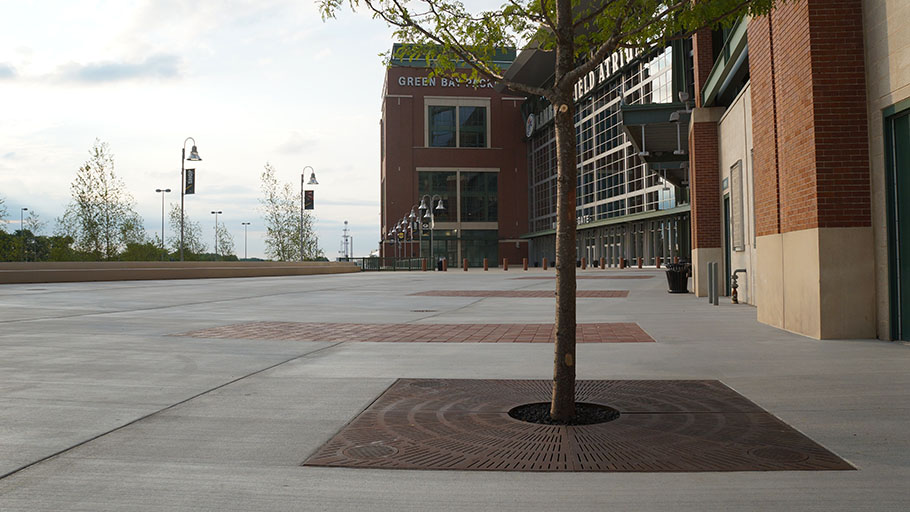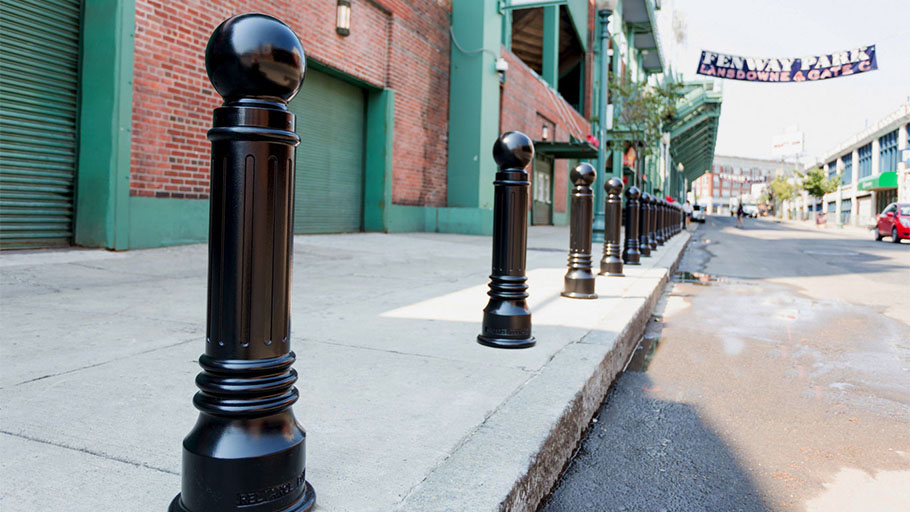A wintery city that prioritizes year-round active transportation
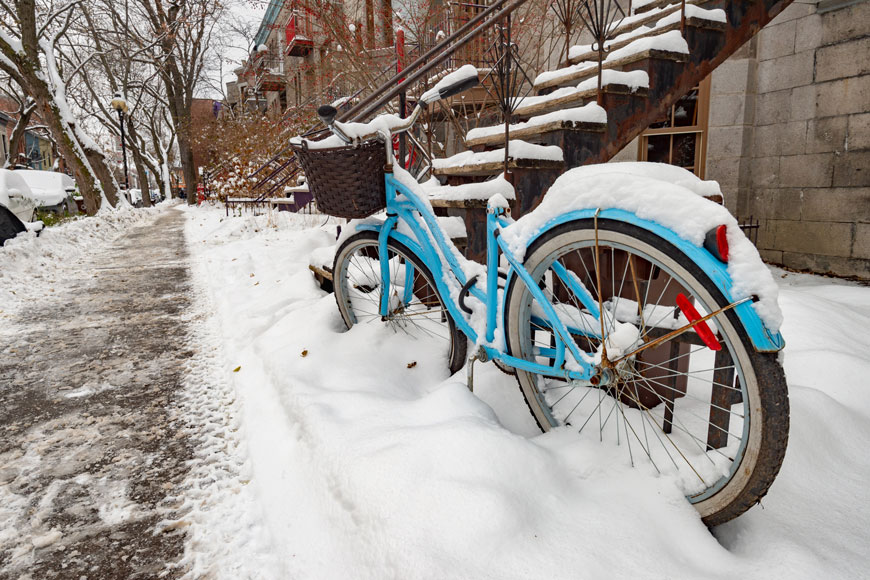
Even committed cyclists are sometimes wary about getting on their bicycles in wintertime. Icy roads, piled snow, and biting winds can chill a rider’s enthusiasm to suit up and get outside. Yet once people get on their bikes in winter, they often find it less intimidating than they’d anticipated. One city with a growing population of year-round riders is Montreal—a wintery Canadian city with 82 inches of snowfall per year. Montreal’s been a cycle-prominent city for two decades, yet it is recent that infrastructure and culture have shifted enough to encourage more winter cycling.
In North America, Montreal has been a clear leader in supporting cyclists both through government policy and NGOs. A 2015 study by Vélo Québec documents an active and growing cyclist population: 53% of Montrealers identify as cyclists, up from 25% in 2000. Non-profit organizations in Quebec are vocal advocates who also provide resources to the cycling public. A recent campaign 2 roues 4 saisons [fr] (2 wheels, 4 seasons) by Environment Jeunesse, shared by others like Vélo Québec, is helping cyclists get out there all year. Although fewer people commute in winter than the rest of the year, growing awareness and infrastructure means that in 2017, there was 14% growth in winter ridership[fr] compared to the previous three years.
An increasing rider base in turn helps drive infrastructure spending and urban planning priorities. A safer, more connected bicycle network encourages new ridership. As culture and planning affect one another, interest snowballs.
How Montreal encourages year-round cycling
Montreal’s urban plan
Montreal’s current development plan features investment in and focus on public and active transportation. Cycling infrastructure and pedestrian protection are important parts of such a plan. The offered strategic vision includes reducing dependence on automobiles, to enhance street-level economic and social engagement, and to lower the city’s carbon footprint. Whether developing health, heritage and ecological sites, to maintaining commercial and industrial zones, every sub-section of the regional plan accommodates bike, pedestrian, and transit commuters. Transport “deserts” are addressed with a multi-modal approach, supporting both vehicle traffic and active-transport infrastructure. Specific measures have been taken city wide to support cyclists.
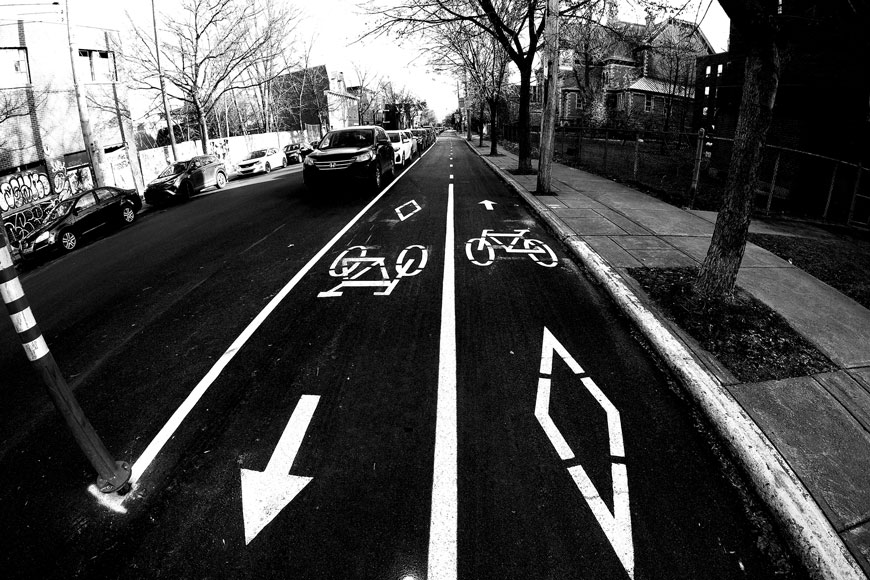
A comprehensive cycling network
Montreal’s 2017-2018 cycling action plan added 58 kilometers of bike paths through the city, bringing the total to 846 total kilometers, or 525 miles. The cycle network is not as developed as the car network, of course. On many small residential streets, cars and bicycles will share the same space, and throughout the network there are designated shared roads. Yet the cycling map increasingly allows people to cross the city on bike without having to cross through spaces where cyclists are unwelcome or unwatched for. Additionally, downtown intersections feature “bike boxes,” or pavement areas painted green that give priority to cyclists, either starting them first at the light or helping with safe turns.
These improvements help encourage year-round bike share, by making people feel more secure with cycling. A cyclist who is uneasy sharing the road with vehicles has enough to concentrate on even in summertime. A cyclist who feels confident on the road can give more attention to cycling in all types of conditions.
One of the ways we can see this progression is through the data provided by “cyclist counters” that monitor the number of people using a specific route. There are two cyclist counters in Montreal. One of these is on Laurier Avenue, watching a dedicated bike lane. The bike lane was installed in 2011, and two years later, the eco-counter was added. The route was already well traveled when the counter was installed, noting an average of 2000 trips per day. Bike share has kept increasing since then. At the height of summer traffic, Laurier Ave saw 10% increase in traffic between 2013 and 2018. Yet it is the winter cycle share that boasts the most impressive growth. In these five years, cycle traffic for January jumped 540%. People confident of their cycling network became more confident of their routes even in wintertime.
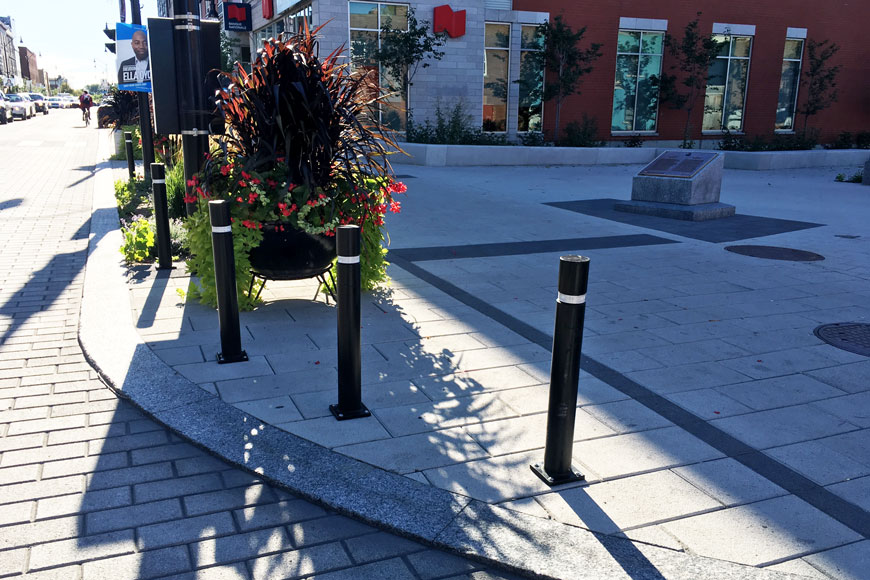
Dedicated bike lanes and protected walking areas
As in many cities, Montreal’s bike lanes are often painted onto the road surface without a physical barrier between vehicles and bikes. These painted lanes, or bandes cyclables, comprise most of Montreal’s biking grid. Although these are better than shared roadways, in general, cyclists prefer dedicated bike lanes. Montreal is unusual in that a majority of residents (cyclists and drivers alike) agree that separated bike lanes are the best solution, with 80% of Montrealers supporting a physical separation between the two. This agreement is leading to the slow conversion of painted bike lanes to dedicated bike lanes, especially in busy downtown areas.
In many cities, the addition of bike lanes is controversial, because it is seen as increasing road congestion. Montreal, an island, is already in the top 100 most congested cities in the world! Yet increased bike lane development since 2013 has not had a marked effect on congestion, either positive or negative.
In areas where painted bike lanes get added separation, Montreal uses a variety of methods to create a barrier, depending on street and traffic conditions. Curbs, flexible polyurethane bollards, parked cars, and tactical surfaces keep traffic in its marked lane.
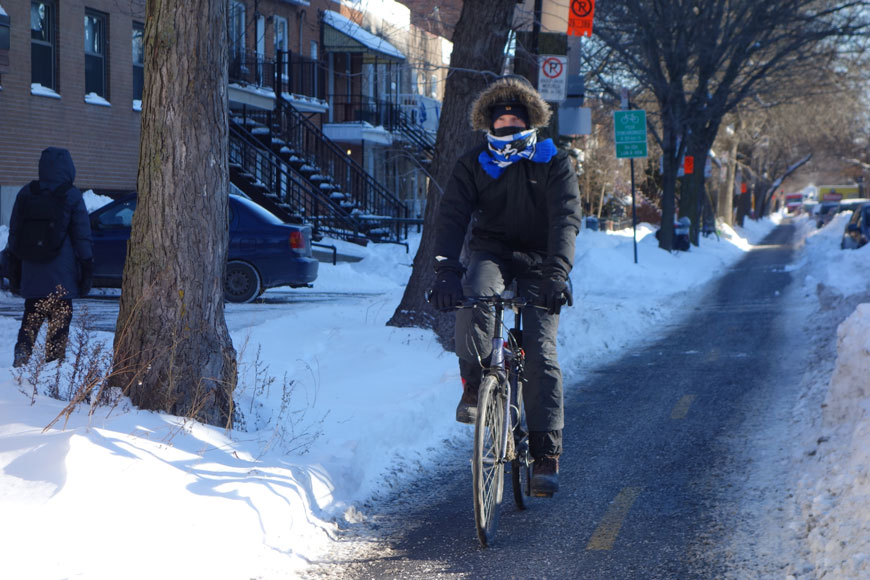
Plowing
Infrastructure is not the only needed investment in a transportation network. Maintenance is an ongoing requirement.
In Montreal winters, this means dealing with snow, by clearing sidewalks and cycle lanes as well as plowing streets. The city has years of experience and a willingness to experiment. Traditional plows, with salt and abrasives, get the job done in most areas. However, new approaches are always being evaluated, including with this icebreaking machine, sized to fit a bike path, sliding between sidewalk and flexible bollard.
Bike parking
Parking infrastructure is vital for areas that encourage cycle commuting. Outdoor commercial racks are the most commonly installed type of bicycle parking. However, the winter weather can be tough for bikes sitting outside all day, with precipitation and de-icing chemicals hard on the chain and frame. A ride parked outside can also feel unappealingly cold and wet to climb onto at the end of the day. Further, bikes parked outside all day experience a higher risk of theft compared with bikes parked for a few hours.
For these reasons, an increasing number of employers are finding ways for employees to park their bikes off the street. Parking garages can add racks and cages, and find themselves parking many bikes where one or two cars used to go. Other organizations allow employees to bring bikes into their offices. This is not always possible. In some offices space is at a premium. Others cannot handle the wear and tear of bikes banging on walls or dragging-in slush and salt. In these places, bike lockers are becoming a best-of-both-worlds solution. They provide outdoor parking with indoor benefits.
Winter tips for riders
Cleared bike lanes and good parking can make a big difference to people’s confidence in riding. Riders can also give themselves a boost following a few winter tips.
Clothing for winter riders
The clothing that people need for cycling in winter is not very different from any other cold-weather activity. People’s needs vary with their natural metabolisms, so each rider must find what works for them. As with all cycling, it’s important to wear clothes that allow comfortable movement. Denim is sometimes more challenging in the winter, getting heavy and cool. Some like a waterproof layer for wet snow and slush. For the truly committed, riding when snow is falling, ski goggles can keep stinging snow away from eyes. Cycling is exercise, and even in the cold, people get warm and sweaty. Wicking fabrics, layers, or a change of clothing for trip’s end are all year-round strategies.
Many riders find that keeping their extremities warm makes all the difference in winter comfort.
Hand-covers: Riding a bike invites wind. Cyclists’ hands are often first to get cold, since fingers are catching wind out front while gripped around handlebars. Even the slight chill in the air of a spring day can leave uncovered fingers feeling stiff and cool. To combat winter’s cold, gloves are the first choice for most riders. Mitts can be challenging for bikes with brake handles and shifters. Further, it’s easier to adjust straps or packs with gloves at the start of a ride, and to lock the bike at the end. One odd but highly effective invention that combines the warmth of the mitt with the dexterity of a glove is the “Bar Mitt.” These are neoprene covers that go over the bar. Riders slide gloved hands into them to grab the handlebars. Neoprene is water-proof and cuts the wind, helping fingers stay toasty.
Boots: There’s a point where riders who roll with clipless pedals most of the year switch to flat pedals in the winter. Shoes for clipless pedals are not usually designed with heat retention in mind, and the metal cleat that hooks into the shoes’ soles bring cold right inside. With flat pedals, any boot works. There are also neoprene covers for regular shoes which can make for a warm ride even without thick winter boots—depending on the temperature and needs of the rider. Further, with a slippery road surface, many riders just feel more comfortable with feet free.
Head-covering: Riders often wear their regular helmets on top of a thermal headband, cap, or hood. A snood or scarf (tucked so it doesn’t dangle and catch) keeps icy wind from chilling a rider’s core. In very cold climates, a balaclava can make a big difference with wind chill. Those that are out for many hours—trail riders and sport cyclists—sometimes invest in winter helmets that come insulated and are specially designed to pair with ski goggles.

Bike mods for riding in winter
In some conditions, where streets are groomed and salted, people simply ride their regular tires. One common option is to let a little air out of the tires so that there is a greater surface area in contact with the road; the only caution is the tire not be so low that turning a corner will cause a pinch-flat, where the rim of the tire and the road pinch a hole in the tube.
For icy conditions and added confidence, studded tires are an excellent choice. As with all tires, very high-end options are available, yet even less expensive tires are quite effective. They are reasonably priced when compared with transit passes or car options. Chains are another option, great for new snow and powder.
Winter days are usually shorter days, and every cyclist needs to be well lit to be visible to drivers. Lights on the bike, with white in front and red in back, are vital. It’s wise to have reflective surfaces on jacket, pack, or pants for additional visibility.
Wiping off excess salt and keeping bike chains lubricated can help the bicycle itself stay in good shape even in weather conditions that challenge working parts.
Awareness of conditions
Road conditions can be very changeable in the winter. Sudden snow can affect visibility. A thaw can turn to slush, which can refreeze to ice: this ice can contain the tire tracks of other cyclists that, when frozen, can catch a tire like train tracks would. Depending on bike, commute, and rider, it’s important to know what the forecast is and what you and your bike are capable of handling.
Community support
One of the best ways to get ready to cycle in all weather is to reach out to others already winter riding. Online forums like Reddit’s r/wintercycling can offer tips and tricks but also just foster excitement and confidence. If you just want to give it a try, events like Winter Bike to Work Day offer a one-day experience to see if winter riding works for you.
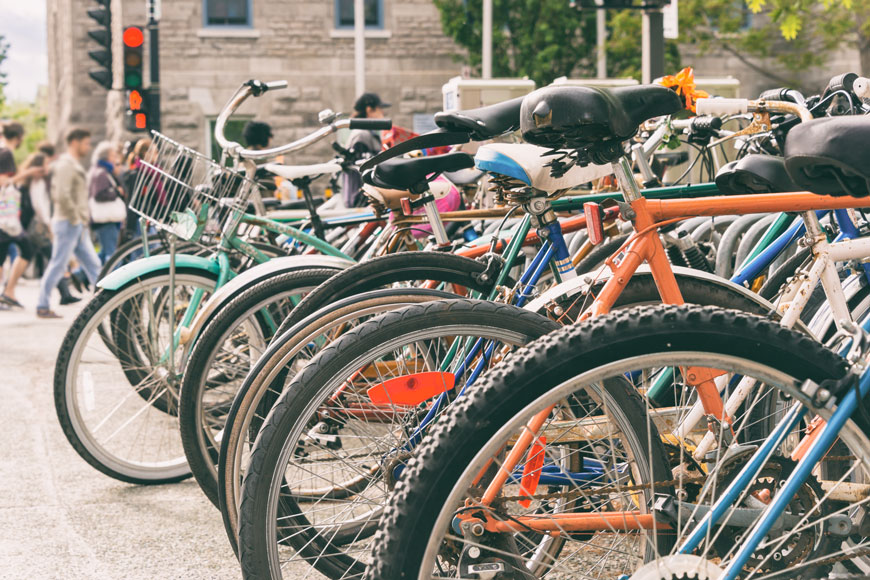
Creating an active transport culture
Montreal has been a leader in cycling culture in North America, but other cities are rapidly catching up. From New York to Portland, more and more people are getting on their bicycles as part of their daily routine. Having infrastructure allows more people to join in, providing safety to people of many different skill and comfort levels. Infrastructure is also vital for winter cycling, with separated bike lanes, plowing or other ice removal, and excellent parking.
As people become more confident on their bikes, they often ease into winter riding by just staying out a little longer in the year. Although a lot of expensive new gear is not really needed, it is helpful to remove clipless pedals and replace with flats, and to make sure tires are not at maximum inflation, so that more tire surface grips the ground. In places where there will be ice, studded tires are definitely worth the investment. As with all cycling, preparing for weather conditions with layered clothing and a change of clothes provides comfort on the ride and whatever comes after. Winter cycling is slower to gain popularity than summer cycling, and may always attract fewer riders, but it is worth experimenting with both on a personal and public level, in cities whose urban plans prioritize active transportation.










